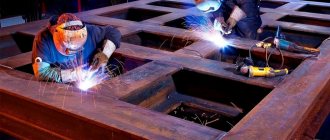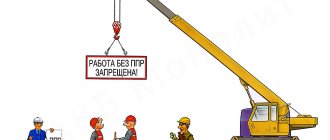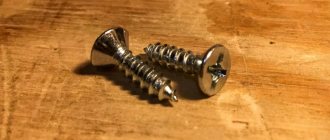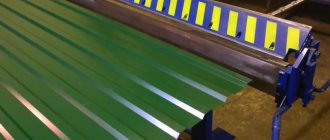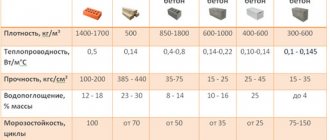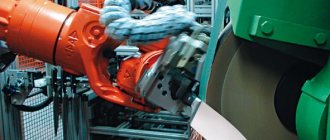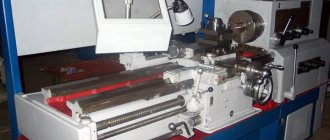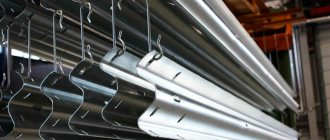- Main types of mechanical processing of metals
- Methods of mechanical processing of metals with removal of the top layer
- Metal machining equipment
- Modern types of metal machining
- Ultrasonic processing of metal parts
- Electrical discharge machining of metals
- Waterjet machining of metals
- Abrasive processing of metals
Today there are quite a lot of ways to process metals and alloys: casting into the desired shape, heat treatment, exposure to electricity and chemicals. However, metal machining today remains one of the main methods for manufacturing most mechanisms and parts for them. The main feature of the machining of metal parts is that, with the help of external influences, its parameters change, but the internal structure does not.
For such work, various types of cutting tools are mainly used: broaches, cutters, drills, taps, cutters, etc. Operations are performed on special metal-cutting machines - each type of metal machining has its own equipment. All operations must be performed strictly in accordance with the technological map. At the same time, compliance with safety regulations is strictly monitored.
In this publication, we will consider methods and types of mechanical processing of metal, as well as the equipment used for processing.
Main types of mechanical processing of metals
Milling
Turning
Mechanical processing of metal can be done either with or without removing the top layer. Operations involving the removal of the top layer include: metal turning, metal drilling, metal crushing, gear hobbing, metal planing, metal chiselling, metal grinding. Operations without removing the top layer include pressure and impact. In this case, the metal part is impacted using presses, water, air under high pressure or an intense flow of abrasive particles (for example, sandblasting). Such procedures can be carried out under the influence of elevated temperatures or in natural temperature conditions. This category of metalworking includes stamping, metal rolling and pressing. Below we will look at the most common methods of machining metal parts with removal of the top layer (cutting)
Methods of mechanical processing of metals with removal of the top layer
These methods involve the use of tools with the obligatory presence of a cutting edge: cutters, drills, cutters, taps, reamers. Machines for such work can be either multifunctional or designed to perform only one operation. Before starting to process a metal part, a drawing with exact dimensions is first developed. After this, one or more methods of processing the part are selected - for example, you can cut off the excess layer of metal, and then turn and polish it, after which the metal is machined according to the drawing. The choice of necessary operations depends on several factors:
- Physical and chemical properties of metal.
- Dimensions of the workpiece.
- The final shape of the part.
- Surface roughness.
Milling
It is one of the most common methods of processing metal parts. As the name implies, a milling cutter is used as a cutting tool. During operation, the cutter itself rotates at the required speed, and the metal workpiece is gradually fed into the cutter. The work is carried out on metal milling machines. During the work process, shavings are removed from metal parts.
Depending on the purpose of the work, the workpiece can be placed in the mill vertically, horizontally, or at the desired angle. The cutter itself is a tool for cutting metal with one or more cutting edges. The main goal of milling parts is to obtain various indentations on their surface.
Drilling
This operation can also be classified as one of the types of metal cutting. The process involves creating holes of the desired diameter using a rotating drill. The purpose of drilling is to make a hole for threads or to accommodate fasteners, such as bolts.
In industrial conditions, drilling is performed using specialized equipment. However, there are many tools for manual drilling - electric, cordless and hand drills, powerful screwdrivers, etc. Depending on the density, hardness or other properties of the metal, the necessary drills are selected - diamond, carbon steel.
Turning
It involves processing metal parts using sharp cutters on special lathes. During operation, the metal cutter slowly moves in the transverse or longitudinal direction. The workpiece itself rotates at the required speed. The purpose of metal turning is: cutting grooves, giving the workpiece the required shape, precise facing, cutting threads. Part turning is one of the most ancient methods of processing metal parts.
Grinding
Produced mechanically or manually. The purpose of sanding is a thin, rough top layer. For mechanical grinding, grinding wheels coated with a layer of abrasive grains are used. The main stage of grinding is the rotation of the grinding wheel. With the help of grinding, we achieve the most exact compliance of the part with the specified parameters.
Reaching out
One of the types of cutting. It is produced using a special multi-toothed tool called a “broach”. Broaching is one of the main processes used in mass and batch production of metal parts. Broaching allows you to process both the outer and inner sides of metal parts. With the help of broaching, you can ensure the highest accuracy of the dimensions and shape of the part. Broaches are one of the most expensive tools used in metalworking.
Gear hobbing of metal parts
This technology for processing metal parts is used for the manufacture of various types of gears: sprockets for chain drives, gears of different sizes, couplings, wheels - helical and spur, rims, etc. All work is performed on a special gear hobbing machine. Its main part is a milling cutter of a specific shape, which cuts the desired tooth profile. Gear hobbing is in great demand in areas such as aircraft manufacturing, automotive manufacturing, general mechanical engineering, and the aviation industry.
Thread cutting
There are various ways of cutting threads on metal parts, from which we can highlight:
1. Thread cutting using a turning tool.
Thread cutting in this way is carried out on universal lathes using the action of the cutter on the part. Carving is produced by rotating a metal part and simultaneous movement of the cutter fixed in the holder of a lathe. During the mechanical removal of the metal layer using a screw stroke, a thread is obtained. After setting up the machine, it is possible to cut both external and internal threads. It is worth noting that to cut internal threads, it is necessary that the internal diameter of the workpiece allows this to be done.
The method of cutting threads on a lathe is most suitable for single, piece execution or small-scale production, since the productivity and speed of the lathe is not significant and the work will be performed at low speed. Typically, this cutting method is used for cutting threads on worm shafts and lead screws. The advantage of this method is its accessibility and ease of operation on a lathe. The second big advantage I would like to note is the accuracy of the work and the quality of the resulting thread.
The advantage of this method is its accessibility and ease of operation on a lathe. The second big plus I would like to note is the accuracy of the work and the quality of the resulting thread.
2. Thread cutting using a die and tap.
The die is a round cutting tool with an internal thread and a smooth entry. Dies come in a variety of features and designs. There are also dies not with a round shape, but with clamp (sliding) ones.
Dies are used for cutting threads on the outer part of the part, the maximum die diameter is 52mm. This type of cutting tool is used in assembly, construction and various production workshops. To cut external threads of larger diameter, use another tool, we will write about it later.
For cutting threads on metal parts of large diameter, specially designed dies are used. These are sliding dies - they consist of two halves, they are inserted into a special holder, it is called a die, and then, as the two parts of the die are shifted towards each other, threading occurs.
Now let's talk about how internal threads are cut on parts. Taps are used to cut internal threads. The tap is a durable metal rod with threads and helical grooves to form edges. They are necessary so that metal shavings come out and do not clog, breaking the tap. There are two types of taps - hand and machine. For cutting threads with a hand tap, one type is not enough, as this will lead to its breakage. It is necessary to use two or three taps (they are sold under numbers 1,2,3) depending on the type of thread being cut, metric or pipe.
3. Thread rolling.
It is the most in demand and popular in the field of metalworking and the production of metal products. To roll threads on parts, thread rolling machines or special devices, rolling rollers for a universal lathe, are used. The main mechanism is a three-headed head or roller holder and a knurling roller. In terms of efficiency and quality, this is the best option to obtain a thread with precise parameters. The whole point is to roll the thread through the mechanical action of the rolling roller on the part; it, as it were, deforms the surface without removing the metal layer with a cutting tool. A metal part or workpiece is clamped between special dies and cylindrical rollers with existing thread marks. During this operation, a thread is formed on the workpiece or part according to the thread shape of the knurling rollers themselves. The process is used to roll small diameter threads.
Metalworking machines
Among the equipment for small production we can name universal machines.
"Snail". The compact machine will allow you to process metal. There are manual and larger analogues. The mechanism is used to give a curved shape to metal pipes and rods.
The “Master” machine will find application, which will give the metal shape and direction. The equipment supports a wide range of attachments.
Mini metal machine Profi-350
You also need a turning machine (for example: “Profi”) for forging and decoration, creating handmade fences.
Metal machining equipment
Today, many enterprises offer such a service as custom machining of metal parts. To carry out such work, many machines have been developed, which are constantly being improved. Thus, primitive metalworking machines today in all serious industries have long been replaced by automatic lines. Enterprises that are developing invest considerable funds in modern high-tech equipment. In this way, the company can guarantee that custom metal machining will be carried out to the highest level. Any enterprise will benefit if it prioritizes the production of high-quality products using modern equipment, regardless of the volume and complexity of the order.
Any serious metal machining shop should have at its disposal such equipment as:
- Milling machines.
- Radial drilling machines.
- Boring machines with rotary barrels.
- Grinding machines.
- Gear hobbing machines
- Vertical drilling machines.
- Equipment for broaching parts.
It should be noted that today human participation in the process of processing metal parts is minimized: almost all modern machines have CNC (computer numerical control). Such machines allow you to make parts with precise geometric parameters in a minimum amount of time and achieve the desired level of surface roughness.
Equipment used
Mechanical processing is used at specialized enterprises provided with a sufficient amount of production space and the necessary equipment.
To remove surface layers, the product is processed on a lathe and milling machines. The most popular among them are:
- CNC turning centers;
- vertical milling machines.
New models of working fixtures make it possible to maintain high geometry accuracy and surface roughness.
Equipment that allows you to process material mechanically is available in a wide variety. Each enterprise independently decides on the need to purchase a particular device. For example, some industries have rotary machines capable of processing products up to 9 meters in diameter.
The standard equipment that is equipped with any enterprise that processes metal products mechanically includes the following devices:
- milling;
- gear hobbing;
- radial drilling;
- horizontal drilling;
- vertical drilling.
Ultrasonic processing of metal parts
This technology is one of the types of mechanical processing of metal parts. Its essence boils down to the fact that under the influence of ultrasound the top layer of the material is destroyed. The treatment is not carried out by ultrasound itself, but by a mixture of abrasive particles that are driven by sound with a frequency of 16 to 30 kHz. The sound is produced by the blows of a special instrument.
In this case, abrasive particles act as cutting tools, so they are subject to increased requirements for hardness. Thus, ultrasonic processing uses small particles of boron carbide, electrocorundum, etc.
Using ultrasonic processing, it is possible to form a metal part along a through contour using a special hollow tool. In addition, ultrasonic processing technology makes it possible to process blind holes of various shapes, and at the same time achieve high precision and cleanliness of the processed surface.
If you use ultrasonic vibration technology during the grinding process with a conventional diamond wheel, you can achieve a higher surface quality and eliminate defects associated with grinding. The processing speed of metal parts during ultrasonic processing depends on indicators such as density, hardness, shape and size of the workpiece, as well as the type of abrasive particles and modes used in the processing process.
Woodworking machinery
As a rule, woodworking machinery is characterized by processing hard wood or peeling off part of the material in layers to give the desired shape using various materials and attachments. There are methods for preserving the mass of the material while taking into account giving it a new shape. The wood material is bent into any shape using pressurized steam, which does not change any of the positive aspects of wood. Stationary sawmills such as chain saws and circular saws are used in sawmills.
Saws for construction sites and workshops
Much smaller, but no less powerful, are hand-held circular saws, construction saws, miter saws and sliding table saws, which are well-used on construction sites and workshops around the world.
Table saw
Circular saws also include panel saws, which can be found in the small particle board industry.
Material reduction
Cutting a solid piece of material to the desired length or width requires special technical tools made of wood, such as the widely used planing mechanism. Today, in addition to the traditional version, there are also electric planing machines. These mechanisms use a rotating blade roller even in their large scale industrial equivalents.
Milling machines
A milling machine is an important element of a woodworking complex. The circular saw function is used to work using a rotating special tip. The milling machine has found application for the manufacture of wooden profile parts and for modifying certain areas on boards and various flat materials.
Milling machine at home
Mechanisms of the highest category are CNC milling machines. The machine is equipped with a milling head that can penetrate from various directions to process any type of product that can be created.
Improving CNC
CNC machines are used to create complex molds for high-quality serial production.
Drilling machines
Boreholes are often inserted into wood products for pins, threaded pins, bolts and many other insertion ingredients.
Drilling machine
The drilling mechanism range is also a mechanism for machines that are used to place dowels and pins into pre-drilled holes.
Cylindrical turning
The simplest machines for wood turning are expansion devices for conventional drilling machines. Today's industrial woodworking machines are computer controlled and can be relied upon to deliver parts of consistent quality and size.
Final polishing
Grinding and polishing machines are responsible for completing the final woodworking processes. They eliminate even the most minor imperfections and create a soft, smooth foundation for continuous processing. The machines used are belt sanders, which can be in the form of electric hand tools to industrial equipment for mass production.
Grinder
Wood processing creates very fine dust that penetrates even the smallest cracks in the mechanisms and turns into a type of plaque that is difficult to remove. If there are electrical components, they are at risk of short circuiting.
Electrical discharge machining of metals
This technology of mechanical processing of metals involves the destruction of a layer of material under the influence of a high-power discharge that occurs between the surface of the part and a special electrode. The principle of operation of this technology is based on the effect of a high-temperature discharge on the metal. A huge amount of thermal energy is released in the discharge channel in a short time. It is capable of heating a gas environment to several thousand degrees.
Thus, due to the thermal conductivity of the environment, a heat flow is concentrated at the discharge site, which almost instantly heats up the surface of the part adjacent to the discharge zone, while evaporating a small amount of metal. This creates an erosive notch. To ensure the necessary operating conditions for the discharge with the required parameters, as well as to effectively remove residual erosion products, the part is placed in a process liquid. As a rule, ordinary water, oil or kerosene is used for this purpose.
The main advantage of electrical discharge machining is the ability to work with metals of any strength, including carbide. In addition, the electroerosion method allows you to make holes of any complexity.
Waterjet machining of metals
When using this technology, the workpiece surface is exposed to a mixture of water and abrasive particles. As a result of this processing, part of the material is removed from the surface of the part. As a result of using waterjet processing, the surface of the product becomes clean and matte, and there are no risks inherent in processing with blade material. The impact of abrasive particles on the surface of the part is very short-lived and has a purely impact nature. In addition to the abrasive, chemicals are added to the mixture, which simplify and speed up the processing process.
The main difference from metal cutting is that waterjet processing leaves virtually no marks. In addition, as a result of bombarding the surface with abrasive, the fatigue strength of the surface of the workpiece increases. As you know, absolutely all metal machining processes require great effort and are accompanied by the release of a large amount of heat, which can lead to deformation of the surface of the part. When using waterjet technology, the surface temperature of the part does not change.
